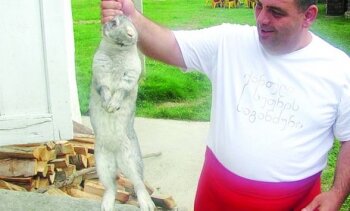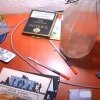
Ema Tukhiashvili
Last summer chef Malkhaz Maisashvili travelled to nearly all corners of Georgia and studied recipes of Georgian traditional dishes directly from the locals. The chef whose experience counts many years and whose professionalism is second to none, was astonished by what he saw and tasted. His stories convinced us that Georgian dishes are the real treasure, which must be collected by visiting all regions of the country.
Malkhaz Maisashvili: We visited various parts of Georgia, searching for recipes of old Georgian dishes. So far we visited only small part of Georgian regions. And there is still some work to be done including processing of recipes. When we are over, we will include these old dishes in the menu of restaurants.
Our visits took place last summer. First we called in Achara (western Georgia, Black Sea coastal region). We were especially interested in the highland Achara. We wanted to collect survived old recipes from the locals. When we visited the villages, we told the villagers the purpose of our travel. They were eager to share their knowledge with us. Almost all Georgians know about Acharian dish called Borano. But it turns out there is another variation of Borano in Achara called Naghmibora. It is made of Kaimaghi (milk cream) and cheese. Another interesting dish is Iakhni. We also wrote down Kezhera Pkhali and Malakhto Lobio (green haricot) recipes. In the highland Achara, dishes are mostly made using dairy products. We collected several recipes of Sinori which is made of matsoni and cheese. There is an interesting dish made of dried plum. It is called Kaisagh. Dried plum is boiled in sugar syrup. During boiling we add butter or boiled butter. In Achara all dishes have butter or boiled butter as their ingredients. As the locals explained, in old days at the breakfast, people used to consume huge quantities of boiled butter with sweets, meat or anything else before going to work.
Q: What did locals make of your initiative?
A: The word spread instantly in villages about Tbilisi people who came for old recipes. They were approaching us to narrate their stories, told to them by their grand moms. We were preparing the dishes and tasting them together. Of course, we could not cook all the dishes there. With some dishes, we had to limit ourselves to writing down the recipes. In certain cases, we had to watch the preparations of certain specific dishes. Without visual knowledge, we would not be able to prepare them by ourselves only according to the recipes.
Q: Could you tell us about some of them?
A: For example, there is this dish Naghmibora made of naghebi and cheese. Naghebi is heated to a certain level and then twisted cheese is added. If you do not know and reach the specific temperature, either cheese will crumble or the dish itself won’t be tasty or “appealing”. More to it, if you add cheese before the right moment, the dish will become watery. Likewise, during Kaisaghi preparations, dried plum should not be left in water too long or else it will become viscous. So, we should take out plum and add fat in time.
Q: Where did you go next?
A: Samtskhe-Javakheti. As you know, it is a highland region too. So dishes there are similarly made of dairy products mainly. There I tasted Apokhti Khinkali. It was very delicious. It is made of large pieces of beef. Every piece is folded in dough like a pelmen and boiled. In Samtskhe-Javakheti they eat ordinary snail dishes too but only in the certain period of the year. I was lucky that it was exactly the period of snail eating during my visit.
Q: Did you find dishes unknown to you in Racha?
A: Yes, just imagine, I came upon a number of such dishes, about which I had never heard of before. I learnt how to prepare all of them. Take for example, a dish made of wild hare. They call it Tabutsuni. They make satsivi from the hare meat fried in tone (satsivi is a national Georgian dish usually prepared for the New Year celebrations). Mamisoni from beef is also very mouth-watering. It is seasoned with onion and pomegranate. Everyone knows about the potato fried in ham. Yet, we learnt a different method of preparing this dish. Finally, we wrote down recipes for green haricot dishes such as Chachriula, Shetsurula, pkhali soup. In Racha they call Chadi-Khachapuri the cheese staffed inside Chadi. Hmm, it’s delicious!
Q: Did Kakheti (eastern Georgia) surprise you with anything?
A: In Kakheti we penned down cornel dish recipe. The Kakhetian table constituents such as Khashlama, Dedali and Mtsvadi are extensively explored dishes in Georgian restaurants. There are much less unknown dishes than, say, in Achara or Svaneti. In Svaneti there are really so many unknown dishes that I was gaping in amazement. For instance, take Zinhora. It is a type of Kupati (meat staffed inside animal gut and prepared in this form) which is made of bull blood seasoned with a variety of flavors. They pierce the bull in its heart with a dagger and kill it in this way. Then they collect the blood in a special vessel, season it and staff inside the guts. Well, this may sound somewhat scary but tastes good at least. They also make dish from cattle or bull meat. They call it Naldzihora.
In Svaneti we learnt to make Khachapuri with Onions, Lukme with Millet (same as Petvnaari – grinded millet mixed in Khachapuri). I did not hear about any other recipe of making Kupdari (dish from the Svanetian cuisine) in Saventi, nonetheless I learnt how to do real Kupdari. In the past, one of its necessary ingredients was cannabis seed, i.e. cannabis seed was used as a seasoning. In Svaneti I tasted real Chvishtari (cheese baked in corn flour). It’s a miracle. Everything acquires a different taste after having been baked in a Svan oven.
When we went to Samegrelo, I told to Megrelians that while they added cheese to chadi flour (corn flour), Svans add chadi flour to cheese.
Q: Did Imereti surprise you too?
A: In Imereti we learnt how to make calf Chashushuli. It turned out that they are doing this famous dish in an utterly different way.
All the dishes that we have collected recipes for are mostly eaten with hands. They are prepared in wood basins and offered to guests with hands. Finally, everything prepared there has unique taste because of air, water and grass (which provides flavorings)… - because all these have their bearing on the taste of dishes. For example, you cannot make anywhere else as good Lori as the one made in Racha. I used to be going crazy about haricots made by my grandma. You would bite your fingers at then taste of it. When she would visit me, I would ask her to prepare her style of haricots – but here it did not have the kind of taste as in Racha.
P.S. The story of Mr Malkhaz boosted our interest in Georgian dishes and culinary tourism. Frankly, it was a tremendous appetizer too. So, our dear readers, we promise you that as a follow-up the Georgian Journal will also travel around every Georgian region and wire tasty reports to you.




















































